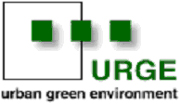 |
 |
 |
 |
 |
 |
Framework summary

Name of the Framework
Urge:
Interdisciplinary Criteria Catalogue (ICC)
Brief description of the framework and tools within it
The URGE Framework consists of three main parts:
1. A toolbox;
2. Good practices;
3. The ´Green City of Tomorrow´.
The essential part of the framework is the toolbox which helps in analysing and evaluating the actual state of the green space system in a city.
1. The toolbox comprises three parts: city profile, Interdisciplinary Catalogue of Criteria (ICC), evaluation methods. The city profile contains a questionnaire template for self- assessment and deals with the general structure and organisation of the city in relation to the urban green spaces. The ICC integrates ecological, economic, social and planning aspects of urban green spaces organised through a set of four criteria groups. The part ´Evaluation Methods´ discusses two evaluation methods for enabling the user to identify problems in the performance or provision of urban green spaces.
2. The Good practices part provides examples of urban green space development and management throughout Europe.
3. The "Green City of Tomorrow" is an overview about challenges expected to be faced by cities in near future. This part presents ideas for strategies and makes recommendations for working towards greener cities.
The framework targets civil planning authorities and private planning institutions and organisations.
Specific topic focussed on by framework
Development of urban green spaces to improve the quality of urban life. And particularly:
• Green-blue spaces quantitative aspects: ratios in urban areas;
• Green spaces qualitative aspects: improvement of the existing green/blue spaces quality;
• Efficient functioning of green spaces
Web link
http://www.urge-project.ufz.de/default.htm
How are the tools organised within the framework?
The ICC is operational in two levels: the city as a geographical unit (city level), and the individual green space in the city (site level).
Each level of operation comprises four groups of criteria related to the (1) quantity; (2) quality; (3) use and (4) planning, development and management, of urban green spaces.
• Criteria group No1 (quantity of urban green spaces) evaluates the physical characteristics of the urban green spaces (quantity, shape, fragmentation etc.). It includes mainly quantitative indicators.
• Criteria group No2 (quality of urban green spaces) evaluates the inherited contribution of the urban green spaces to the city environment e.g. biodiversity aspects.
• Criteria group No3 (use of urban green spaces) identifies and analyses the type and range of uses and determines the general trends in the usage patterns.
• Criteria group No4 (planning, development and management of urban green spaces) helps to analyse how comprehensive the green space planning and management regimes of the city are.
Sector/s covered by framework
Waste |
Energy |
Water |
Transport |
Green/Blue |
Building & land use |
0 | 0 | 0 | 0 | M | 0 |
What language/s is the framework available in?
The toolbox is available in four languages: English, French, German, Hungarian
The booklet is only in English
What organisation developed the framework and in what country?
The toolbox is developed under the EU 5th Framework, Key Action "City of Tomorrow and Cultural Heritage" by a consortium of 12 organizations from the fields of research and practice in six countries: United Kingdom, The Netherlands, Finland, Germany, Hungary and Italy. 15 European towns and cities have actively participated in the elaboration of the toolbox as partners and referenced cities.
Where is the framework available from?
http://www.urge-project.ufz.de/default.htm
What are the strengths of the framework?
• Clear aim, objectives and structure of the framework
• Well balanced economic, environment, social and planning aspects of the urban green spaces
• Comprehensive sector explanations, examples and criteria
• Proposed evaluation methods are tested in real practical situations and could be applied in particular contexts according to the end-users preferences.
• Tracing of the historical development of green planning, comparison with current practice and recommendations for efficient planning with regard to the long-term future of the urban green spaces.
What are the weaknesses of the framework?
• Mainly sector specific - no particular relation to the other urban systems and infrastructures;
• One of the proposed evaluation methods could be used only with specific software ? not clear whether it is paid or free.
What other interesting information is available about the framework?
Interesting, attractive and aesthetic presentation of the framework. Strongly recommended especially to experts in the field of green space planning.